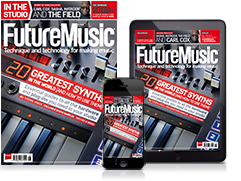
1. The quick list
2. Best for singing
3. Best wireless option
4. Best for field recording
5. Best for video
6. Best for podcasts
7. Best for YouTube
8. More options...
9. Buying advice
10. How we choose products
Remember when phones were just phones? Now, of course, that black rectangle in your pocket can be all kinds of things, from a games console to a portable cinema screen. But one of our favorite advancements has been the way in which the humble iPhone has evolved to become a fully-fledged portable recording studio. However, you will need one of the best iPhone microphones to take advantage of this.
Apple’s latest iOS devices are super capable, blazingly quick, and – most importantly – always with you. The best microphones for your iPhone need to be equally present, equally capable, and an improvement on the phone’s built-in microphone.
In this guide, we’ll show you some of the best microphones for iPhone, as well as highlight some of the features and functionality you should be looking for when making your decision. If you want to do some more research before you purchase, then make sure to have a look at our buying advice section at the bottom of this article.

When Simon's childhood classical guitar teacher boasted he 'enjoyed a challenge', the poor man had no idea how much he'd underestimated the scale of the task ahead. Despite Simon's lack of talent, the experience did spark a lifelong passion for music. His classical guitar was discarded for an electric, then a room full of electrics before Simon discovered the joys of all things recording. Against all odds, Simon somehow managed to blag a career as a fashion journalist, but he's now more suitably employed writing for MusicRadar and Guitar World. When not writing or playing, he can be found terrifying himself on his mountain bike.
Best iPhone microphones: The quick list
Want to see the very best iPhone microphones without scrolling through endless walls of text? Well here you'll find a selection of our favourites, with links to read more if you want to.
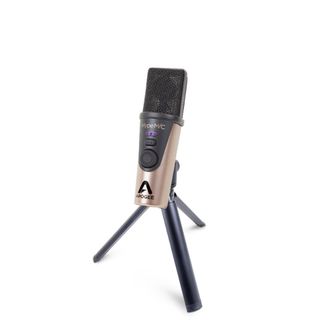
If you're looking to get a great sound for your singing, the Apogee HypeMiC delivers impeccable sound quality and has a built-in compressor to keep things sounding smooth.
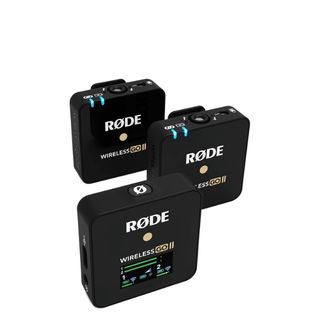
Don't want cables cluttering up your creative space? The Rode Wireless GO II is used by the BBC, so that gives you some insight into its superb quality audio and pro features.
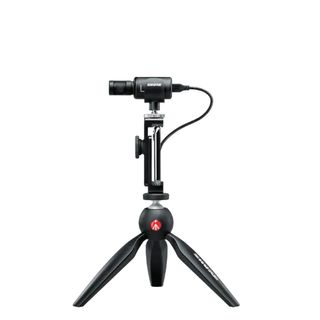
If you need great sound on the go then the Shure Motiv MV88+ is perfect for field recordings. The package contains everything you need to get set up, wherever your recordings take you.
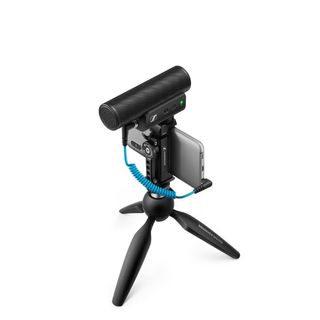
If you need to turn your smartphone into a full-on video rig, the Sennheiser MKE 400 MKII is based on a legendary DSLR mic, and comes with a shock mount and windshield.
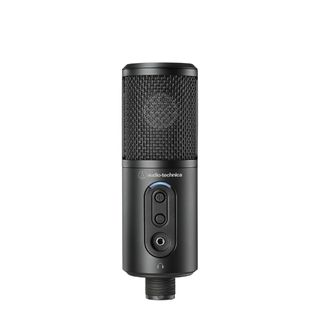
If you're starting your own podcast, the Audio-Technica ATR2500x-USB is an inexpensive, yet high-quality option. We love the built-in headphone jack with volume control on it.
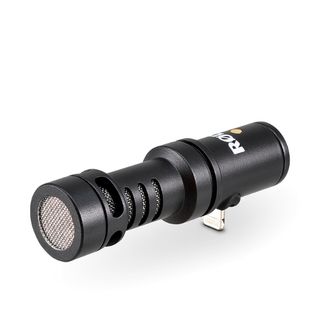
We love the utter simplicity of the Rode VideoMic Me-L, which makes it perfect for budding YouTubers looking to get their channel up and running with just themselves and their iPhones.
The best iPhone microphones available today
MusicRadar's got your back
Here you'll find full writeups and reviews of the best iPhone microphones you can buy today. Many of these have been personally tested by our team of writers, so you can rely on our recommendations.
Best for singing
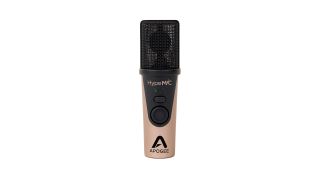
We were blown away by the Apogee HypeMiC when we reviewed it at the tail end of 2021. It's one of the best thought-out solutions we've ever come across for vocalists, podcasters and musicians who want to record with their iOS devices.
The stand-out feature is the HypeMiC's analogue compressor, which evens out soft and loud sound sources. Three settings are available – Shape, Squeeze and Smash – each progressively adding more compression to your input. Real-world uses include everything from injecting life into delicate instrument recordings to isolating quiet vocals from busy backgrounds. We found the results to be quite remarkable, almost magical.
The HypeMiC also gives you fine control over the recording process. A chunky gain wheel enables easy and immediate gain adjustment, guided by a triple LED meter that lights up red when overloaded. The headphone port at the base of the HypeMiC provides the opportunity to directly monitor your input signal with zero latency, but you can also blend in the output from your DAW.
It's not the cheapest product here – far from it – but the HypeMiC does ship with a neat travel case, a robust tripod and a pop filter. It also comes with a handful of cables that make it compatible with most iOS devices, Apple Macs and even Windows PCs.
As you'd expect from Apogee, this is a pro-quality mic, both in terms of build and sound, with a price tag to match.
Read the full Apogee HypeMiC review
Best wireless option
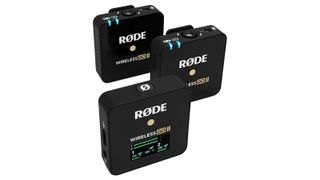
Rode is one of the best-respected names in microphone technology, so it figures that its premium broadcast mics will be a bit special. The Rode Wireless GO II combines a couple of discreet clip-on ‘pucks’ which transmit to a central receiver unit, which can be connected to your iPhone.
We’ve seen these used on location by the BBC, among others, and features like the safety-channel recording, which records a secondary version of your audio at a lower volume in case of noise spikes on your main clip, can prove a godsend when you’ve got only one chance to get it right.
For the standard bedroom vlogger, this set might prove a little over the top. Rode has a wider range which is well worth checking out, if that’s the case. But if your iPhone doubles up as a tiny pro-grade studio, then the Wireless GO II set should be high up your list for consideration.
Best for field recording
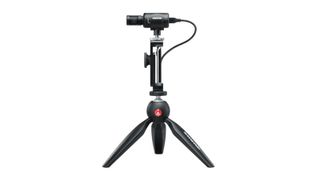
Just a few years ago, Shure launched its original Motiv MV88 Lightning-based mic, which flew off the shelves. It's still available today, but this updated version, the Motiv MV88+, just goes to show how much technology has moved on since that first release. If you're looking to turn your humble iPhone or iPad into a full-blown vlogging or field recording rig, then this is the kit for you.
The Motiv MV88+ no longer relies on Apple's proprietary Lightning standard; instead it uses USB and ships complete with both USB-C and Lightning cables, broadening its compatibility greatly.
The Video Kit version (confusingly, this seems to be the standard version in some markets) also bundles a phone clamp, a Manfrotto tripod and a shoe-mount mic clip, making it good value if you're starting from scratch. Despite the 'Video' nomenclature, this kit is also a practical proposition for field recordists – it’ll keep your rig neat and tidy, with everything readily to hand.
The clever thing about the Motiv MV88+ is its integration with ShurePlus's remarkable MOTIV app, which is available for Mac, Windows, iOS and Android. With this, you can dig deep into the Motiv MV88+'s DSP settings, alter EQ, adjust gain, choose alternative mic configurations (stereo, mono cardioid, mono bidirectional, mid-side, etc), change stereo width settings and much, much more. This transforms the Motiv MV88+ into a hugely versatile mic system that’s suitable for tackling a wide variety of creative endeavours.
Shure knows how to build its mics tough, and the metal construction of the Motiv MV88+ feels characteristically robust. Hopefully, it’ll outlast your current iOS device – and maybe the next one, too.
Best for video
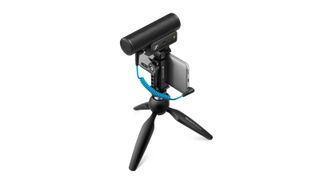
What feels like a lifetime ago – back when the DSLR video boom first kicked off – Sennheiser's MKE 400 became the go-to budget shotgun mic for many videographers. Finally, after many, many years, Sennheiser has updated its ageing device with a shiny new model (actually, it’s matte black) – and guess what? It's now compatible with mobile devices, too.
The MKE 400 MKII is a rather nifty bit of kit. Admittedly, its chunky-yet-handsome form factor, complete with hot shoe plate, looks better perched on top of a DSLR than an iPhone, but don't let that put you off.
This mini shotgun mic is now equipped with a 3.5mm TRRS-compatible jack, which means it's simply a matter of running a short cable between it and the headphone socket on your iOS device. Of course, very few iPhones and iPads now have a headphone socket, so you'll probably have to source an inexpensive adapter – see more below.
Its super-cardioid shotgun pattern enables the MKE 400 MKII to home in on your subject, rejecting noise from everywhere but the centre front. This is a very useful quality to have when faced with capturing barely audible dialogue.
Two things we really love about the MKE 400 MKII are its slickly designed integrated shock mount and its windshield. Its low-cut filter is another welcome feature, one that's so characteristically Sennheiser.
This isn't a particularly expensive microphone, but you get the sense that Sennheiser's engineers have fought hard to ensure that it performs better than a mic at this price point really should. The only criticism we have is that the three-step gain sensitivity switch is a bit limited in use.
The MKE 400 MKII is also available in a mobile kit form with a bundled tripod and phone clamp.
Best for podcasts
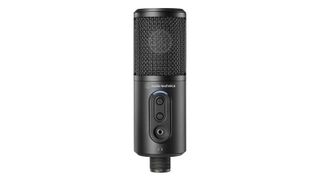
Here's a no-nonsense cardioid condenser vocal mic that'll plug directly into the latest USB-C-equipped iPads without the need for additional adapters, hubs, interfaces and other unwelcome clutter.
Audio-Technica has developed this mic for cash-strapped creators who nevertheless value quality audio. Unashamedly inexpensive, simple to set up and painless to use, it's perfect for those who'd rather invest time producing captivating content than getting bogged down in technicalities.
Aimed primarily at podcasters, the ATR2500x-USB's cardioid pattern successfully rejects unwanted noise from the sides and rear, while the low-mass condenser diaphragm reproduces vocals with a good level of clarity, detail and authenticity.
Despite its reasonable price tag, its all-metal construction feels reassuringly hefty, so it should survive a few knocks. Audio-Technica also bundles a nifty little tripod with this mic.
Best for YouTube
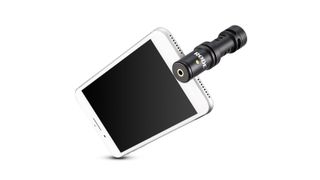
One of the huge advantages of vlogging with an iPhone is that you don't have to juggle an inordinate amount of kit. You can enjoy travelling light, with just your phone and perhaps a small GorillaPod. Adding an iphone microphone is, of course, a wonderful idea, but the thought of carrying extra cables, a chunky condenser mic and a phone bracket can quickly kill that carefree, shoot-anywhere vibe.
Røde's VideoMic Me-L will add substance to your audio, but at a mere 28g it's hardly going to weigh you down. It's unlikely to get you heavily in debt either, lightening your wallet by less than the cost of a rather average meal out for two wannabe influencers.
There's really not much to it. The VideoMic Me-L is simply a small-diameter, 7cm-long shotgun mic that clips directly to your phone's Lightning port. There's a headphone socket around the back for monitoring, which is welcome, but no other controls.
Bearing in mind its target market, we applaud this mic’s simplicity. We also love the fact that it's made from robust aluminium rather than potentially polluting plastic.
Sound quality is surprisingly good, with its cardioid pattern and mini shotgun design successfully rejecting a lot of unwanted noise. Røde even throws in a furry windshield.
More options...
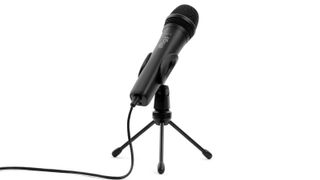
This is by far the most interesting microphone in this guide. Most of the others we've featured do much the same thing, but the iRig Mic HD2 has some unique features that may just make it the perfect iPhone mic for you.
IK Multimedia claims that it’s the only handheld digital condenser mic on the market that's compatible across iOS, Mac and Windows. It certainly looks more like a handheld mic than the assortment of oddly shaped appliances we often see clamped to vloggers' phones. Its silhouette is reassuringly familiar, and straightaway the robust metal housing feels right at home in the hand.
While we can't imagine many scenarios in which you'd want to perform live with a handheld microphone tethered by a USB cable to your phone, we do recognise the huge potential this mic has for broadcasters conducting live interviews. Having the option to pass a mic from host interviewer to guest interviewee and back again is a godsend for anyone striving for audio excellence.
Of course, if you're a studio-based musician, performer or podcaster, there's nothing to stop you placing it on a stand and using it just like any other microphone. IK Multimedia even includes a tripod with it.
Another feature that caught our attention is the bundled Mic Room modelling software that transforms the iRig Mic HD2 into one of a number of iconic microphones. But that's not all – in typically generous IK Multimedia fashion, this mic also ships with Ableton Live 11 Lite plus a host of audio processing plugins.
Freebies aside, the iRig Mic HD2 performs brilliantly straight out of the box – the sound quality is just superb for a mic at this very competitive price. It’s definitely worth considering if you need to get hands-on with a mic.
Read the full IK Multimedia iRig Mic HD2 review
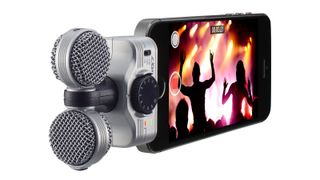
The iQ7 has been around for some years now, but that's testament to how good this mic is. Ideal for a multitude of uses – from podcasting and vlogging to seeking out atmospheric ambient field recordings – this inexpensive little mic excels at capturing wider, more authentic stereo images.
Setup is easy, provided you're happy setting recording levels and stereo width. Just click the Lightning connector home – there's a removable shim for those who rock a case – set the mic orientation to either video or audio, and you're almost there.
Gain level is set using the big forward-facing dial, aided by a triple LED meter on the front panel. You can connect headphones to the iQ7's mini jack socket for monitoring, or use it as a line output jack.
The stereo-width switch is where things get interesting. Setting it to 90 degrees will ensure that the mic focuses predominantly on sounds coming from the centre of your scene, while selecting 120 degrees will see it picking up more ambience and stereo width. On the M-S setting, it’ll record a file that allows the stereo width to be tinkered with manually in Zoom's free Handy Recorder app.
Recording with the iQ7 requires slightly more forethought than if you were recording with its X-Y-equipped sibling the iQ6, but you’ll be rewarded with more control and a much-improved stereo image. For less than $/£/€100, it’s hard to fault this little gem.
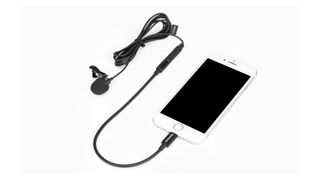
Sometimes, we get carried away in the belief that we need a big, impressive microphone that costs the price of a kidney, when, in fact, all we really need is a cheap, humble lavalier.
Pin the discreet LavMicro U1A to your lapel and your voice will sound distinct and clear. Move and it’ll move with you, so your voice will still sound distinct and clear. Buy an extension cable and you'll be able to walk a fair distance away from your iPhone or iPad and still be heard as if you were standing right next to it – distinct and clear.
What's special about the Saramonic LavMicro? Er, nothing really. Interesting features? Hmm, none. It just does what it's supposed to do, without fuss or ceremony (although Saramonic does include an alligator clip and a pouch).
We concede that the quality probably wouldn’t be good enough for Adele's next album but, trust us, it's plenty good enough for broadcast and vlogging.
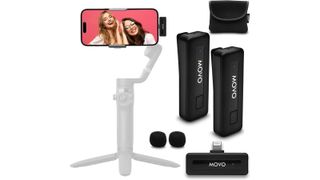
With iPhones being used more and more as complete videography solutions, it makes sense that we’d see more wireless lavalier mics reach the market. The Movo Wireless Mini set is a great example, offering up two clip-on mics with a decent battery life and fairly broad range, which connect wirelessly thanks to a Lightning-equipped receiver device that connects to your phone.
Pairing is instantaneous, meaning you can be up and running within seconds of making a connection. Bass is, as you’d expect from such a small mic, pretty non-existent, so you can forget capturing deep velvety baritone speeches, but as an inexpensive entry point, we think this is a neat little set.
Best iPhone microphones: Buying advice

Are iPhone mics worth it?
We expect a lot from the microphones in our iOS devices. One minute we're taking a voice call from work and the next we're trying to send a voice note to make our evening’s arrangements. Realistically or not, we expect the audio to be pristine – but more often than not, we're disappointed.
The reason we're disappointed is because we have unrealistic expectations. No microphone can perform well under all conditions; it's physically impossible. Instead, Apple has very sensibly equipped its iOS devices with omnidirectional (omni) condenser mics. These are very sensitive, picking up sound from all sides, while naturally overcoming the proximity effect – a (usually) undesirable low-end boost when close recording.
These characteristics make them superb for recording voice calls, when your mouth is very close to the device, but they are less than ideal for isolating a subject from a busy background. An omni-condenser mic can be especially sensitive, too, which is why your subject will often be drowned out in a sea of ambient turmoil.
In addition, if you're using Apple's basic Voice Memos app to record audio, be aware that it relies on auto-gain to set recording levels. It tends to boost every faint ambient sound it picks up, substantially increasing background noise. Fine for capturing basic ideas, but nigh-on unusable in a digital audio workstation (DAW) like Garageband or Logic.
Fortunately, investing in a separate microphone and setting gain levels manually can overcome all of these issues.
What is the pickup pattern of a microphone?
Every microphone is designed with a specific polar pattern (aka pickup pattern), which simply explains the direction (and area) from which it will capture audio. Different recording scenarios and applications call for different patterns, so carefully consider how you plan to use your iOS device.
As we've already established, omnidirectional microphones – which have a very broad pattern – aren't ideal for recording in all situations, but that doesn't mean we should disregard them completely. They work exceptionally well for singing, especially when close-miked, which makes lavalier mics a great choice. These are the tiny mics broadcasters often wear, usually clipped to a lapel or other item of clothing close to the talent's mouth. Because they're close miked, they're unlikely to pick up much background noise, and that omni pattern means it's not strictly necessary for them to be accurately pointed at the sound source. This makes lavaliers much easier to place and conceal. Equip your iPhone or iPad with a lavalier – either wired or wireless – and you’ll be able to record excellent spoken audio, making them ideal for podcasts or outside interviews.
Cardioid mics are more focused. They're most sensitive to sounds from the front, capturing little from the sides and rear. This makes them a good choice for semi-isolating vocals or other sound sources from ambient noise. They’re susceptible to the proximity effect – that boost in bass frequencies as the mic is brought closer – but this can be desirable depending on the result you’re trying to achieve. They’re particularly useful for capturing one or two subjects from a few feet away, or for recording distant soundscapes.
Super-cardioids and hyper-cardioids have increasingly narrow patterns, which makes them ideal for isolating your talent from their surroundings, provided they don't move sideways, beyond the mic's pattern.
Figure 8 mics are only really found in mid-side arrays (more of which below). They’re bidirectional, picking up sound from the front and rear but rejecting sound from the sides. That said, slightly confusingly, in a mid-side configuration they are orientated to pick up sound from the sides and reject from the front and rear.
Typically, mics for iPhones and iPads will be omni or cardioid, because those patterns cover most applications well. Don't be under the illusion that a narrow polar pattern will enable you to successfully pick out a distant sound source, especially vocals. It doesn’t work like that. Always try to mic reasonably close to your talent, or you'll end up with an unusable amount of noise. For more advice, read our guide to recording the very best vocal performance.

What is the capsule in a microphone?
If your iPhone microphone accessory features just one capsule (a single mic), then it's almost certainly going to be an end-address, which means you just point it directly at your subject or talent.
Some microphones boast dual capsules. These are usually in an X-Y configuration but occasionally you'll find them in a mid-side configuration. Which is better? An X-Y configuration will see two microphone capsules set up diagonally opposing one another, most often at 90 degrees. It provides recordings with an excellent stereo image and is easy to use – imagine a straight line bisecting the two mics, and aim that at your talent. It provides little stereo width control, although some products may allow you to increase or decrease the angle of the capsules.
Mid-side arrays comprise one cardioid mic pointing directly at the action (the mid), together with a second mic, usually in a figure 8 pattern, picking up sounds from the sides (the side). Balancing the input of the two mics, either pre- or post-production, will enable you to increase the stereo image, or focus more on the talent. In a nutshell, a mid-side array will give you more control over the ambience and directionality of your recording, but they’re a bit more of a faff. If you just want to point and shoot, with little concern for choosing settings, go for X-Y.
Which is better condenser of dynamic mic?
Most Lightning-connector iOS mics will be condenser mics. These have active circuitry and are designed to be very sensitive, enabling them to accurately capture low frequencies, high frequencies and everything in between. Unfortunately, that sensitivity can make them quite 'lively', in that they'll also excel at recording low-end rumble and high-end clatter and hiss – stuff like the central heating, cutlery, the clink of glasses, and so on.
Dynamic mics, on the other hand, are passive, and far less sensitive. This makes them less accurate, but it also means that they work well in noisy, untreated rooms. You're unlikely to find one that uses a Lightning port, but they’re readily available with USB, XLR and TRS connections, so if your set-up includes an audio interface then you should consider whether a dynamic microphone might be better suited to your needs.
Can I connect a microphone to my iPhone?
Apple's connector implementation across its current range is a bit of a mess. The recent announcement of Apple’s newest models – iPhone 15 et al – featuring a USB-C connection will help simplify things in the future but there might be a few years more faff before the transition is complete. Until then, you’re looking at either Lightning or USB-C connections, depending on which model iPhone you have.

Can I use XLR mic with iPhone?
While it makes perfect sense to use either USB or Lightning-equipped microphones with your iOS device, there's no getting away from the fact that the pro standard is still XLR. This is a very mature standard that uses robust, balanced, noise-cancelling cables – if you want to invest in a top-end mic, it’ll almost certainly have an XLR connector.
If you have your heart set on using an XLR-equipped mic (perhaps you already own one), then how do you go about using it with your iPhone or iPad?
The answer is to use an audio interface. Once again, compatibility can be an issue, but interfaces that appear to work well with many iOS devices include the PreSonus AudioBox iOne and iTwo, the Arturia MiniFuse and AudioFuse, the Roland Rubix series, the Roland GO:MIXER PRO-X and GO:LIVECAST, the IK Multimedia iRig series and the Apogee Symphony. This is by no means an exhaustive list, and once again we cannot stress how important it is to check compatibility with your particular Apple product.
Please don't mistake our cautiousness for negativity. The combination of an M1 iPad Pro, a USB-C-equipped interface and an XLR mic, such as the superb Shure SM7B, will provide you with a powerful rig that surpasses the capabilities of many desktop studios. Still, it's worth investing a little time to ensure that everything plays nicely together.
How we choose the best iPhone microphones
At MusicRadar, our writers are dedicated to the pursuit of pristine audio quality, so we understand that using an iPhone microphone is now a totally valid way to capture audio in the modern age. When it comes to pinpointing the best iPhone microphones, our team leverages their experience from recording studios, live performances, and a genuine love for the details of sound reproduction.
Selecting an iPhone microphone involves a meticulous examination of factors such as clarity, sensitivity, ease of use, and adaptability to different recording situations. We've rigorously tested various microphones, putting them through their paces in real-world scenarios to ensure they meet the diverse needs of musicians, content creators, and audio enthusiasts.
Whether you're capturing impromptu musical ideas or recording professional-grade content on your iPhone, our guides cover a range of microphones, from budget-friendly options to premium choices. Each recommendation in our guide has earned its place through thorough testing, ensuring that whether you're in the studio, on stage, or out in the field, you can achieve exceptional audio quality.
Find out more about how we test music gear and services at MusicRadar.
Related buyer's guides
- Best phones for musicians: top smartphones for music production
- Level up your audio with the best camera microphones

